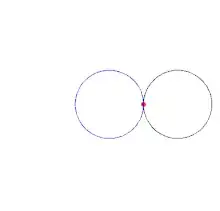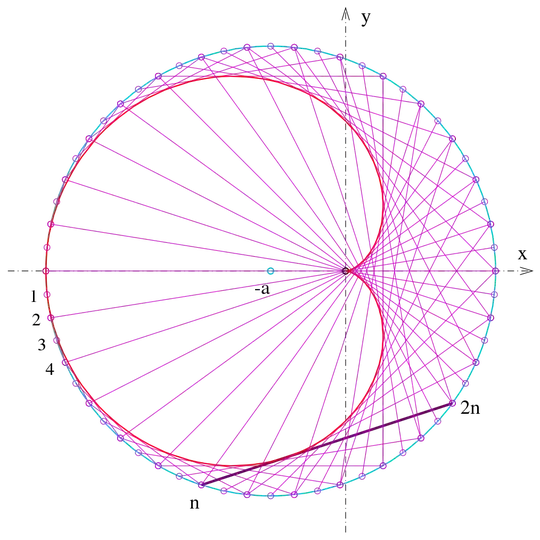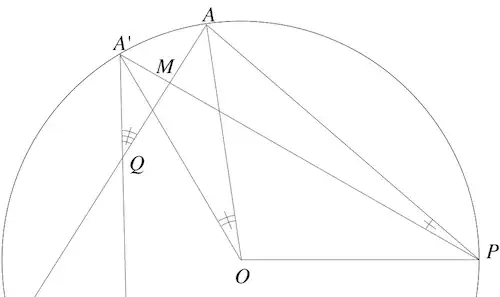First, a bit of animated inspiration:
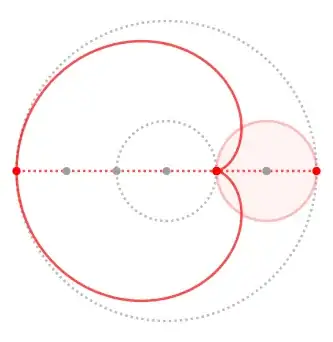
Now, we consider the origin-centered unit circle $\bigcirc O$, about which rolls unit circle $\bigcirc O'$. For $\theta$ the counter-clockwise direction angle of $\overline{OO'}$, we can define $P_\theta$ as the varying tangent point of the circles; $Q_\theta$ as the proverbial "spot of paint" point on $\bigcirc O'$ that traces the cardioid; and $R_\theta$ as the point of $\bigcirc O'$ from $O$, which traces a circle of radius $3$ about $O$. (Note that $P_0=Q_0=(1,0)$.) Let $T_\theta$ be the point where the extended segment $\overline{R_\theta Q_\theta}$ again meets the big circle, and let $S=(-3,0)$ be the fixed point on the far left of the big circle.
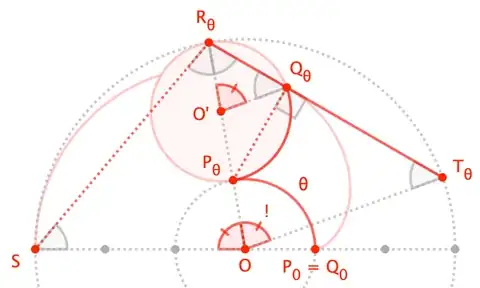
By the rolling definition of the cardioid locus, we know that $\angle P_\theta O P_0=\angle Q_\theta O' O$; equivalently, $\angle R_\theta OS = \angle Q_\theta O'R_\theta$ (as marked in the figure). Light angle-chasing through isosceles triangles tells us that $\angle T_\theta O S = 2\angle R_\theta O S$; thus, thinking clockwise from $S$, we see that $\overline{R_\theta T_\theta}$ is the precisely type of chord described in the definition of the cardioid as the envelope of chords.
"All we have to do", then, is show that chord $\overline{R_\theta, T_\theta}$ is tangent to the locus of $Q_\theta$. This takes a little Calculus.
The parametric form of our $Q_\theta$ (which, note, is shifted one unit right of the standard cardioid locus) is
$$Q_\theta = \left(\;1 + 2(1-\cos\theta)\cos\theta\;,\;2(1-\cos\theta)\sin\theta\;\right)$$
so the tangent vector has the form
$$\overrightarrow{Q'_\theta} \;=\; \frac{d}{d\theta}Q_\theta \;=\; 2\;\left(\;-(1 - 2 \cos\theta) \sin\theta\;,\;(1 - \cos\theta) (1 + 2\cos\theta)\;\right)$$
Observe that, since $P_\theta=(\cos\theta,\sin\theta)$, we can calculate
$$\overrightarrow{P_\theta Q_\theta}\;=\;Q_\theta-P_\theta \;=\;\left(\;(1 - \cos\theta) (1 + 2\cos\theta)\;,\; (1 - 2 \cos\theta) \sin\theta\;\right)$$
which amounts to the "negative reciprocal" of (half of) $\overrightarrow{Q'_\theta}$. The vectors are orthogonal. But $\overline{P_\theta Q_\theta}\perp\overline{R_\theta T_\theta}$ (by Thales), so it must be that $\overrightarrow{Q'_\theta}$ and $\overline{R_\theta T_\theta}$ are parallel; that is, the chord is indeed tangent to the locus, as desired. $\square$
